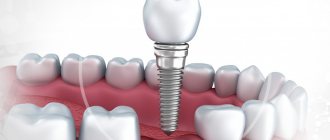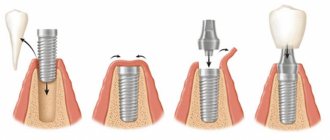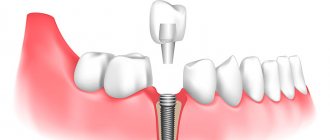Publication date: March 17, 2021
Tooth extraction or extraction is a surgical procedure that inevitably damages the gums. Swelling after surgery is a natural phenomenon, but there are situations when swelling warns of complications.
Gum healing proceeds normally if:
- slight swelling and swelling of the cheeks, disappear within 2-3 days;
- elevated temperature, passes in the same time frame;
Minor pain is also possible after the anesthesia wears off.
It is clear that discomfort when biting remains for up to 10-12 days, but in general, rehabilitation is characterized by positive dynamics.
How long does it take for flux to last after tooth extraction?
Swelling of the gums after tooth extraction continues for varying periods of time. The duration depends on the chosen method of surgery, the condition of the oral cavity and the immune abilities of the patient’s body. On average, swelling subsides in 3-4 days, sometimes lasting up to 7 days. Complications are indicated by persistence of flux for more than a week. Swelling appears 2-3 hours after the operation; along with it, the anesthesia wears off and pain may occur. Sometimes the cessation of anesthesia is accompanied by a slight increase in temperature. Therefore, the dentists at Dr. Fedorov’s clinic prescribe painkillers.
Maximum swelling is observed on the third or fourth day. By the seventh day it should completely go away. It's not just the gums that can become swollen. If your cheek is inflamed after tooth extraction, most likely the process began to develop before the operation.
Why install drainage?
In dentistry, drainage is used in the following cases:
- for tissue healing after removal of a problematic tooth;
- with alveolitis;
- after opening the flux;
- when an abscess or cyst forms;
- for administering medications directly into the wound.
The patient should not worry if his gums were cut and a drainage system was installed. Drainage is used to remove purulent exudate and ichor. If drainage is not installed, the opened source of infection will heal quite quickly after cleansing, but if the inflammatory process is not stopped, the formation of purulent masses will begin again. In this case, a new operation will inevitably be required.
What to do if your gums are swollen after tooth extraction
Monitor your body's condition throughout the week. It is recommended to make an appointment with a doctor if:
- On the fourth day after surgery, the swelling did not decrease, but rather increased.
- A sharp throbbing pain occurs in the jaw, gum or cheek area - not to be confused with the aching pain that appears after the anesthesia wears off.
- The temperature rose to 38℃ and did not subside throughout the day.
- There is a feeling of persistent weakness and general malaise of the body.
- There is pain in the throat when swallowing.
If your gums are simply swollen after tooth extraction and there are no complications listed above, follow the recommendations received from your dentist. The swelling will completely go away within a week.
On the second day after tooth extraction, my cheek became swollen
The cheek does not always swell immediately after the patient’s gum is cut. Swelling may occur the next day - this is also natural. There may be no swelling of the cheek at all; often only the gums suffer. Moreover, everything is normal if postoperative recovery proceeds with the following introductory notes:
- body temperature on the second day is normal - not elevated;
- no sharp, throbbing pain in the gums;
- a day after the onset of swelling began to gradually decrease.
Swelling after resection of the root apex
What is resection? Postoperative period
Recommendations in the postoperative period
Any competent dentist will try to keep the tooth alive, even if a cyst or other inflammation has formed at the top of the root. Fortunately, today doctors have more and more opportunities for this; for example, they can remove a cyst without depulping the tooth. This operation is called resection of the apex of the tooth root. However, swelling often appears after it. Is this normal and what should I do?
Reasons why the cheek swells after tooth extraction
Swelling appears due to the inflammatory process occurring in the mucosa and pulp after surgery. This is a non-infectious inflammation. If operations are carried out correctly and the surgeon’s instructions are followed, the swelling goes away painlessly and without the need to take antibiotics. The integrity of the oral mucosa is disrupted during doctor intervention. The more swollen the gums are after tooth extraction, the more the integrity of the mucous membrane is damaged.
Severe swelling most often appears in patients who have had their wisdom teeth extracted - they generally have large, intertwined roots that complicate the process. The same applies to situations where inflammation began before surgery.
Cheek swelling during wisdom tooth removal
Working with outer teeth is a complex operation. Therefore, swelling always occurs after wisdom teeth removal. Doctors often resort to cutting the gums, after which they apply stitches.
For two to three days after surgery, the temperature may remain above 37℃, and opening the mouth, talking and swallowing may be accompanied by pain. The risk of infection and serious inflammation is higher than with other tooth extractions. The surgeon must prescribe baths with an antiseptic solution and antibiotics. Additionally, it is recommended to eat soft, pureed foods at room temperature, and refrain from sweets, alcohol and smoking.
Indications for surgery
- Cyst due to periodontitis. As a rule, if it is small in size, it is treated with medications. Surgery is resorted to when the tumor has reached more than 1 cm in diameter.
- Poor filling of the canals, which can cause inflammation.
- If treatment is required on a tooth that has a crown.
Thus, root resection helps not only to save the diseased tooth, but also to prevent the spread of infection to healthy tissue.
Other causes of cheek swelling
If you have a tooth removed and your gums are swollen, the cause does not necessarily lie in soft tissue damage. Swelling is possible due to the following:
- performing an operation if the patient has a flux;
- complex course of the operation - due to tooth growth in the wrong direction, strong inclination, removal of large teeth with large, intertwined roots;
- inflammation and infection of soft tissues or tooth roots before surgery;
- allergies or other forms of individual intolerance to anesthesia and medications used during removal - therefore it is important to know exactly what components you are allergic to before removal;
- poor antiseptic treatment of the oral cavity and mistakes made by the doctor during tooth extraction;
- chronic diseases leading to complicated recovery - neuralgia, hypertension, as well as a general decline in the body’s immune functions;
- ignoring prescriptions received from the dentist - for example, independently adjusting the dosage or deciding not to take antibiotics.
Most often, patients' swelling does not subside after tooth extraction due to lack of normal care - skipping medications, complete absence or insufficiently frequent disinfection treatment.
Possible complications
Patients face complications due to incorrect care, complex or incorrect removal. Dentistry distinguishes 5 types of complications:
- Alveolitis - to put it simply, this is dryness of the socket. A blood clot always forms in the latter. It does not need to be removed, since the clot protects soft tissues from the penetration of bacteria and infection. If it is accidentally removed, the mucous membrane becomes susceptible to the pathogenic influence of bacteria, and suppuration may develop. Sometimes the inflammation shifts and spreads - a large area of the jaw, cheekbones and eyes become inflamed.
- Osteomyelitis is bone inflammation. With osteomyelitis, acute pain is felt in the upper and lower jaw, and swelling only increases.
- An abscess is suppuration inside the gum. Can move, leading to loosening of the tooth root.
- Flux is a severe inflammation of the jaw, in which the temperature rises and acute pain appears in the area of the jaw and temples.
- Neuritis is an inflammation in which the motor activity of the facial nerve is disrupted. Neuritis is indicated by swelling of the cheek, palate, tongue and larynx.
How is the drainage tube installed and what does it look like (photo)?
The drainage in the gum (look at the photo) looks like a small tube. Today, experts prefer drainage made of latex or rubber. Both materials are waterproof, due to which the device is retained in the infected tissue for a long time, is well tolerated by the patient and does not allow the wound to heal.
Before installing a drainage system, the dentist must first determine the location of the lesion and send the patient for an x-ray. During the examination, the depth and size of the abscess will be determined.
The doctor's next steps depend on the results of the x-ray. If the image confirms the destruction of the tooth root, the dentist must remove it, and then install a drainage tube into the open hole without an additional incision in the gum (see also: how to remove a tooth if its root remains in the gum?). In all other cases, the drainage procedure includes the following steps:
- administering local anesthesia;
- direct dissection of the gum tissue with a scalpel and its treatment with an antiseptic;
- fixation of the drainage system.
In case of flux, the doctor will make a releasing incision, that is, opening the abscess, after which he will install a system for the outflow of pus.
How to eliminate cheek swelling
It is impossible to get rid of edema 100% before the inflammatory process stops. To reduce discomfort and pain, you can apply cooling compresses for 7-10 minutes with a break of 30-40 minutes. Taking painkillers, baths and rinsing with soothing solutions at room temperature helps.
How to remove cheek swelling after tooth extraction at home
- Avoid contact with the hole. It should not be touched with the tongue, brushed, or allowed to get in contact with food.
- Adhere to dietary restrictions. You should not eat or drink for 4 hours after removal. In the next week, food should be soft, at room temperature, not hot or spicy. Eating sweets is not advisable.
- In the first 3-4 hours after removal, apply cooling compresses to the cheek. It is optimal to keep the compress for 3-5 minutes, maximum – 10-15. The compress can only be done on the first day.
- Rinse your mouth with an antiseptic solution. The main thing is to follow all the dentist’s instructions.
Treatment of inflammation of the oral mucosa
If your gums hurt under your denture, the first thing you need to do is consult with your dentist, who will determine the cause of the problem. Treatment should be based on diagnostic results, since only in this case will it be possible to completely stop the process and prevent complications. The patient must strictly adhere to the doctor's recommendations and should not self-medicate.
If the inflammation is caused by an uncomfortable design of the prosthesis, the doctor will make a correction, which will relieve the discomfort and then the inflammatory process. Sometimes one correction may not be enough, since the patient cannot always point out all the points where the prosthesis rubs. The doctor may also recommend special means to reduce the discomfort that often occurs in the early stages of wearing removable structures . For minor soft tissue injuries, the use of antiseptic agents is sufficient. This could be rinsing with herbal decoctions such as chamomile, calendula or St. John's wort.
If the cause of the complication is the manufacture of a low-quality crown, these measures will be clearly insufficient, the prosthesis should be replaced with a better one. The allergic factor of inflammation after dental prosthetics is eliminated by choosing a different type of prosthesis. Instead of plastic crowns, you should choose cast metal or metal-ceramic structures. An alternative to acrylic removable products is the more modern nylon ones.
We should not forget about maintaining hygiene. Mandatory cleaning should be done twice a day, in addition, after each meal you need to use special rinsing products. To remove plaque, you need to use regular brushes, floss, and brushes. Compliance with all the doctor’s recommendations is a guarantee that the prosthetics will be durable and not cause discomfort.
Date of publication: September 20, 2020 Last update: September 22, 2022 © 2020 Professorial Dentistry “22 Century”. All rights reserved.
Avoid physical activity
The patient is prohibited from doing anything that provokes bleeding:
- engage in any sport;
- lift weights;
- do difficult homework;
- to take a bath;
- go to the sauna and solarium;
- travel for a long time in vehicles or fly on airplanes.
Read also: What antibiotic to take for toothache
Important! If you do not follow these recommendations, the wound will bleed, heal for a long time, and pus may spread into nearby tissues.
Take prescribed medications
Postoperative treatment of purulent gum diseases is supplemented with drug therapy. Usually prescribed:
- antibiotics to relieve infection – most often “Lincomycin”, or analogue drugs “Tsifran”, “Amoxiclav”;
- anti-inflammatory drugs to relieve pain, heat, swelling - “Nimesil”, “Nurofen”, “Nise”, “Ibuprofen”;
- wound healing ointments to speed up healing - “Levomekol”, “Levomethyl”, “Metrogil Denta”.
Additional Information! Medications make recovery easier after drainage is installed. If you do not accept them, the process will be delayed. There is also a high chance of relapse of the disease.
Do antiseptic rinses
An important stage in the treatment of purulent periodontal pathologies is rinsing with antiseptic solutions. Apply:
- chlorhexidine;
- furatsilin;
- "Miramistin";
- "Stomatophyte";
- "Chlorophyllipt";
- solution of soda and salt;
- herbal infusions - chamomile, calendula, sage, oak bark.
The solution should be slightly warm. It is better to make oral baths than to rinse - under the pressure of the liquid you can wash the drainage. Procedures are carried out 3 to 5 times a day.











